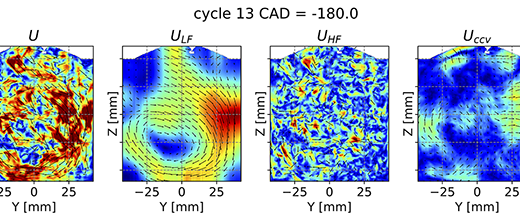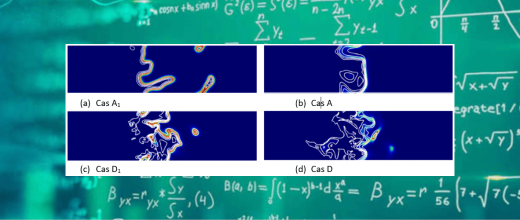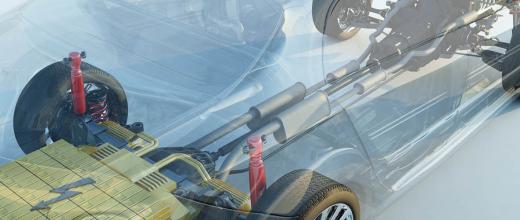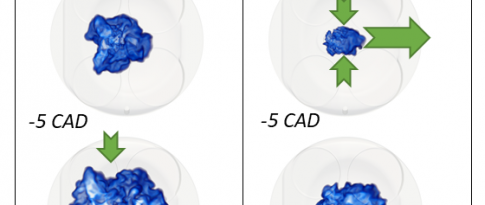Within the framework of a global policy to reduce the emissions produced by the transport sector - particularly road transport - IFPEN is focusing on a complementary option along with vehicle electrification: the use of hydrogen powertrains. However, the use of hydrogen in IC engines first requires a comprehensive understanding of different phenomena, associated, for example, with interactions between the fuel and air. This objective requires advanced modelling tools for the simulation of turbulent reactive flows, as well as dedicated numerical methods making it possible to fully exploit the results obtained.
In this context, Large-Eddy Simulation (LES) is used to realistically reproduce turbulence, thanks to a detailed description of the vortices and particularly acyclical phenomena [1]. However, access to this non-stationary data is not immediate; it requires adapted tools, capable of identifying two types of movements that are potentially the source of the cycle-to-cycle variabilities observed in an engine: the movement of the flow as a whole and the fluctuating movement associated with turbulence.
The method used for this purpose was EMD (Empirical Mode Decomposition), making it possible to effectively isolate the low-frequency and high-frequency components of a signal. Initially developed in 1D, it was extended to 2D for engine applications [2], and then 3D within the framework of a thesis project [3,4]. Its advantages are that it only uses one velocity field for calculations, unlike traditional approaches such as POD (Proper Orthogonal Decomposition), and does not require criteria to isolate the two components, unlike wavelet-type or Gaussian-filter approaches.
Accordingly, via the use of 3D EMD, it is now possible to consider any velocity field during an engine cycle and have access to the variability of major vortex structures between cycles. This is a significant contribution in terms of the analysis and understanding of the physical mechanisms leading to cyclical combustion variabilities. It also makes it possible to define descriptors specific to the high- and low-frequency components of the velocity field, as well as their variability (figure). The impact of different phenomena (valve jets, interaction between walls, tumble movementa, gas injection) thus becomes measurable.
This research led to the development of an innovative technique for defining new turbulent flow descriptors in highly unsteady situations, such as those encountered in hydrogen engines. This technique paves the way for even more in-depth analyses of turbulent aerodynamics, with a view to identifying the mechanisms responsible for certain undesirable phenomena (noise, emissions, etc.) affecting other energy conversion solutions, such as electric machines or wind turbines.

a- Rotational aerodynamic movement around an axis perpendicular to the axis of the piston motion.
References:
- Maio, Giampaolo; Ding, Zhihao; Truffin Karine; Colin Olivier; Benoit Olivier; Jay Stéphane (2022), ECFM-LES modelling with AMR for the CCV prediction and analysis in lean-burn conditions. In: Science and Technology for Energy Transition. Submitted.
- Sadeghi, Mehdi; Truffin, Karine; Peterson, Brian; Böhm, Benjamin; Jay, Stéphane (2021), Development and Application of Bivariate 2D-EMD for the Analysis of Instantaneous Flow Structures and Cycle-to-Cycle Variations of In-cylinder Flow. In: Flow, Turbulence and Combustion, vol. 106, n° 1, pp. 231–259.
>> DOI: 10.1007/s10494-020-00197-z
- Zhihao Ding, Méthodologies d’analyse de l’aérodynamique interne moteur (Methodologies for the analysis of internal engine aerodynamics), PhD thesis, Orleans University, 2022.
- Ding Zhihao, Truffin Karine, Jay Stéphane, Schmidt Marius, Foucher Fabrice and Borée Jacques, On the use of LES and 3D EMD for analyzing cycle to cycle variations of in-cylinder tumbling flow, submitted to Flow, Turbulence and Combustion.
Scientific contacts: karine.truffin@ifpen.fr ; olivier.laget@ifpen.fr ; stephane.jay@ifpen.fr
You may also be interested in
Multiphase reactive flow simulation: developments and applications in the field of combustion (HDR 2015)
The scientific field concerned by my HDR research is the 3D numerical modeling of two-phase combustion, combining research on turbulent combustion and the preparation of the reactive mixture.









